Move over, boring salads! Pomegranate seeds are about to become your new favorite ingredient for adding vibrant flavor and crunch to everyday meals. From quick weeknight dinners to impressive seasonal dishes, these ruby-red jewels can transform your cooking in delightful ways. Get ready to discover 19 delicious recipes that will make you fall in love with pomegranate seeds all over again!
Pomegranate and Feta Salad with Mint
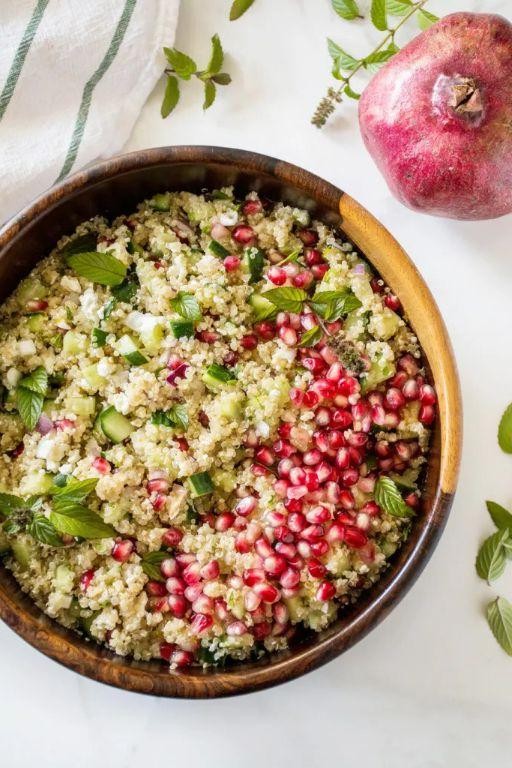
Falling into autumn’s gentle rhythm, I find myself craving this salad more often—the way the ruby pomegranate seeds burst with tart sweetness against the creamy, salty feta feels like a quiet celebration of the season’s shift. It’s a dish that asks for little effort but returns so much brightness, perfect for those evenings when you want something fresh yet comforting.
5
servings15
minutesIngredients
– 1 large head of romaine lettuce, torn by hand into bite-sized pieces (I find the uneven edges hold the dressing better)
– 1 cup pomegranate seeds, freshly scooped from the fruit if you have a few extra minutes—their jewel-like quality always feels special
– 4 oz feta cheese, crumbled into rough chunks (I like the brine-packed kind for extra tang)
– 1/4 cup fresh mint leaves, gently torn to release their fragrance
– 3 tbsp extra virgin olive oil, my go-to for its fruity notes
– 1 tbsp fresh lemon juice, squeezed right before using to keep it bright
– 1/2 tsp honey, just enough to soften the lemon’s edge without making it sweet
– 1/4 tsp fine sea salt, which I prefer for how evenly it dissolves
Instructions
1. Place the torn romaine lettuce in a large, wide salad bowl—using a bowl with ample space makes tossing easier and prevents bruising the leaves.
2. Scatter the pomegranate seeds evenly over the lettuce.
3. Add the crumbled feta cheese, distributing it in pockets so every bite gets a bit of creaminess.
4. Sprinkle the torn mint leaves across the top.
5. In a small jar or bowl, combine the extra virgin olive oil, fresh lemon juice, honey, and fine sea salt.
6. Seal the jar tightly and shake vigorously for 20 seconds, or whisk in the bowl until the dressing is fully emulsified and slightly thickened.
7. Drizzle the dressing over the salad, aiming to coat the ingredients lightly but evenly.
8. Using salad tongs or two large spoons, gently toss the salad for about 30 seconds, lifting from the bottom to incorporate the dressing without crushing the delicate ingredients.
9. Serve immediately to maintain the crisp texture of the lettuce and the pop of the pomegranate seeds. Only now does the salad feel complete, with the cool mint weaving through each forkful and the feta melting just slightly into the dressing. I love how the contrasts play out—crunchy, creamy, tart, and sweet—and sometimes I’ll add a handful of toasted walnuts for extra depth, or serve it alongside warm flatbread for a simple, satisfying meal.
Quinoa and Pomegranate Seed Pilaf
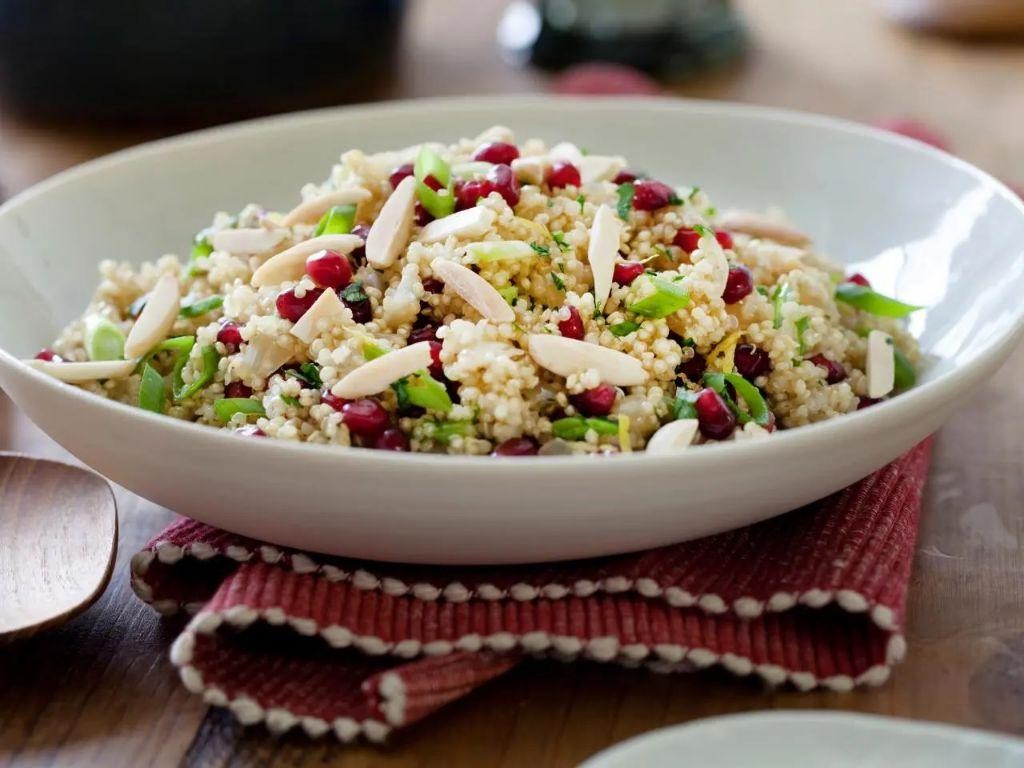
Mellow autumn evenings always find me craving something both nourishing and vibrant, a dish that bridges the gap between summer’s brightness and the cozier flavors ahead. This quinoa and pomegranate seed pilaf is my quiet answer to that seasonal shift, a gentle stir of warmth and jewel-like color that feels like a slow, deep breath in bowl form.
4
servings15
minutes25
minutesIngredients
– 1 cup quinoa, rinsed well (I find rinsing removes any slight bitterness, making for a cleaner, fluffier grain)
– 2 cups vegetable broth (homemade if you have it, but a good-quality store-bought works beautifully)
– 1 tablespoon extra virgin olive oil (my go-to for its fruity, gentle flavor)
– 1/2 cup pomegranate seeds (their burst of tart-sweet juice is the perfect counterpoint)
– 1/4 cup chopped fresh parsley (flat-leaf is my preference for its more robust, less bitter flavor)
– 1/4 cup sliced almonds, toasted (toasting them first, as we’ll do, really wakes up their nutty depth)
– 2 tablespoons fresh lemon juice (freshly squeezed, please—it makes all the difference in brightness)
– 1/2 teaspoon salt (I use fine sea salt for even distribution)
– 1/4 teaspoon black pepper, freshly ground
Instructions
1. Place a medium saucepan over medium heat and add the olive oil, letting it warm for about 30 seconds until it shimmers lightly.
2. Add the rinsed quinoa to the pan and toast it, stirring constantly, for 2–3 minutes until the grains are dry and you can smell a faint, nutty aroma—this toasting step deepens the quinoa’s flavor significantly.
3. Pour in the vegetable broth, then add the salt and black pepper, stirring once to combine.
4. Bring the mixture to a full boil, then immediately reduce the heat to low and cover the saucepan tightly with a lid.
5. Simmer the quinoa for 15 minutes exactly—set a timer, as overcooking can make it mushy.
6. After 15 minutes, remove the pan from the heat but keep it covered, and let it steam undisturbed for 5 more minutes; this resting period ensures the quinoa absorbs any remaining liquid and becomes perfectly fluffy.
7. While the quinoa steams, place a small, dry skillet over medium heat and add the sliced almonds.
8. Toast the almonds for 3–4 minutes, shaking the pan frequently, until they are golden brown and fragrant—watch them closely, as they can burn quickly.
9. Fluff the steamed quinoa gently with a fork to separate the grains and release steam.
10. Stir in the pomegranate seeds, chopped parsley, toasted almonds, and fresh lemon juice until everything is evenly distributed.
Perhaps what I love most is the final texture: the quinoa is tender yet distinct, each grain separate, while the pomegranate seeds offer little juicy bursts that contrast with the almonds’ gentle crunch. Its flavor is quietly complex—earthy, bright, and subtly sweet—making it a wonderful side for roasted chicken or a satisfying main when topped with a soft-poached egg.
Pomegranate-Glazed Chicken Thighs

Often, when the evening light turns golden like this, I find myself drawn to recipes that feel both comforting and celebratory. Pomegranate-glazed chicken thighs have become my autumn ritual—the way the sweet-tart glaze caramelizes against crispy skin feels like gathering warmth against the coming chill.
8
portions15
minutes40
minutesIngredients
– 8 bone-in, skin-on chicken thighs (I always pat them extra dry for maximum crispiness)
– 1 cup pomegranate juice (100% pure, not from concentrate—it makes all the difference)
– 1/4 cup honey (local if you have it, for that floral depth)
– 3 tablespoons olive oil (extra virgin is my kitchen staple)
– 4 cloves garlic, minced (freshly crushed releases the most aroma)
– 1 teaspoon smoked paprika (this adds a whisper of campfire warmth)
– 1/2 teaspoon sea salt (I use coarse for better texture)
– 1/4 teaspoon black pepper, freshly ground
Instructions
1. Preheat your oven to 400°F and position a rack in the center.
2. Pat chicken thighs thoroughly dry with paper towels—this ensures the skin crisps beautifully instead of steaming.
3. In a small saucepan, combine pomegranate juice, honey, olive oil, minced garlic, smoked paprika, salt, and pepper.
4. Simmer the glaze over medium heat for 12-15 minutes, stirring occasionally, until it thickens enough to coat the back of a spoon.
5. Arrange chicken thighs skin-side up in a 9×13 inch baking dish.
6. Brush half of the warm glaze evenly over the chicken skin, reserving the remainder.
7. Bake for 25 minutes at 400°F until the skin begins to bubble and turn golden.
8. Brush the reserved glaze over the chicken, making sure to get into the crevices.
9. Continue baking for another 10-15 minutes until the internal temperature reaches 165°F and the glaze is sticky and caramelized.
10. Let the chicken rest for 5 minutes before serving—this allows the juices to redistribute throughout the meat. The finished dish offers this wonderful contrast between crackling sweet skin and tender, juicy meat beneath. Tonight, I’m serving mine over wild rice with roasted brussels sprouts, letting the pomegranate glaze drizzle down into everything.
Citrus and Pomegranate Seed Salsa
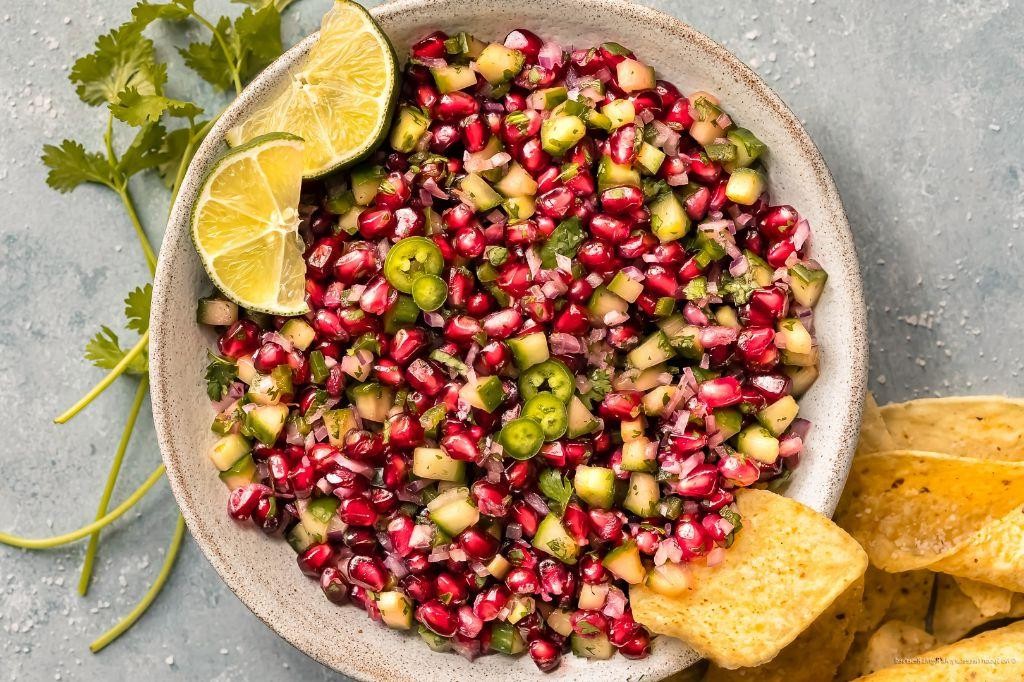
Perhaps the simplest pleasures arrive when we pause long enough to notice them—like the way late afternoon light catches the ruby seeds of a pomegranate, or how the scent of citrus can lift a quiet kitchen from stillness to something softly alive.
2
servings20
minutesIngredients
- 1 large orange, peeled and diced (I like to use a navel orange for its sweetness and minimal seeds)
- 1/2 cup pomegranate seeds (scooped fresh from the fruit—it’s worth the extra minute for their jewel-like brightness)
- 1/4 cup finely chopped red onion (soaked in ice water for 5 minutes first to mellow its sharpness)
- 2 tablespoons fresh lime juice (from about 1 lime, squeezed just before using)
- 1 tablespoon honey (a local, raw honey adds a lovely floral note)
- 1/4 teaspoon fine sea salt (I prefer this over table salt for its clean, even distribution)
- 2 tablespoons chopped fresh cilantro (gently packed—if you’re not a cilantro person, fresh mint works beautifully too)
Instructions
- Place the diced orange, pomegranate seeds, and finely chopped red onion in a medium glass or ceramic bowl.
- Pour the fresh lime juice and honey over the fruit and onion mixture.
- Sprinkle the fine sea salt evenly over the ingredients.
- Using a silicone spatula, gently fold everything together until the honey is fully dissolved and the ingredients are evenly coated.
- Let the salsa rest at room temperature for 15 minutes to allow the flavors to meld—this short rest makes a noticeable difference in depth.
- Just before serving, stir in the chopped fresh cilantro until it’s evenly distributed.
Now, this salsa holds a delicate balance—the juicy burst of pomegranate seeds against the soft citrus, all brightened by that hint of lime. I love it spooned over pan-seared salmon or simply with crisp tortilla chips on a lazy afternoon.
Avocado Toast with Pomegranate Seeds

Cradling my morning mug, I find myself drawn to simple comforts that feel both nourishing and celebratory—this avocado toast, scattered with jewel-like pomegranate seeds, is exactly that kind of quiet morning ritual. It’s a gentle collision of creamy and crisp, earthy and bright, that always seems to slow the day down just a little. I love how it feels like a small, edible gift to myself.
2
servings5
minutes4
minutesIngredients
– 2 slices of thick-cut sourdough bread (the chewy, tangy kind is my favorite for holding up to toppings)
– 1 large, ripe avocado (I wait until it yields gently to a soft press)
– 2 tablespoons extra virgin olive oil (my go-to for its fruity, peppery finish)
– 1/4 cup pomegranate seeds (those little ruby gems add such a happy crunch)
– 1/4 teaspoon flaky sea salt (I prefer Maldon for its delicate, crisp flakes)
– 1/4 teaspoon freshly cracked black pepper
Instructions
1. Place your sourdough slices in a toaster and toast on a medium-dark setting until the surface is golden brown and crisp, about 3–4 minutes.
2. Tip: Listen for the toaster’s click—it’s your cue for perfect crunch without bitterness.
3. Halve the avocado, remove the pit, and scoop the flesh into a small bowl.
4. Drizzle 1 tablespoon of extra virgin olive oil over the avocado.
5. Using a fork, mash the avocado and oil together until mostly smooth but with some small, textural lumps remaining.
6. Tip: A few lumps keep it rustic and prevent it from feeling like a spread—it should still feel substantial.
7. Divide the mashed avocado evenly between the two toasted sourdough slices, spreading it gently to the edges.
8. Sprinkle the flaky sea salt and cracked black pepper evenly over the avocado.
9. Scatter the pomegranate seeds generously across the top of each toast.
10. Drizzle the remaining 1 tablespoon of extra virgin olive oil in a thin stream over the finished toasts.
11. Tip: For an extra flourish, a final pinch of salt over the pomegranate seeds makes each pop of juice even brighter.
But what I love most is the quiet contrast—the creamy, rich avocado against the sharp, juicy burst of pomegranate, all anchored by that sturdy, tangy sourdough. Sometimes I’ll add a drizzle of honey for a sweet note, or serve it alongside soft-boiled eggs for a more substantial breakfast, letting the yolks run into the avocado like a second sauce.
Pomegranate and Walnut Stuffed Peppers

Often, when autumn’s crisp air settles in, I find myself craving the kind of meal that feels like a warm embrace—something vibrant, nourishing, and quietly celebratory. These pomegranate and walnut stuffed peppers are exactly that, a dish born from the desire to gather the season’s best and tuck it all into a tender, edible vessel. Making them feels less like following a recipe and more like a slow, deliberate meditation in the kitchen.
4
servings25
minutes65
minutesIngredients
– 4 large bell peppers, any color you love (I find red and yellow ones are naturally sweeter)
– 1 cup uncooked long-grain white rice
– 1 cup raw walnuts, roughly chopped (toasting them first brings out their deep, earthy flavor)
– 1 cup pomegranate seeds, fresh if you can find them—their jewel-like burst is worth the effort
– 1 small yellow onion, finely diced
– 2 cloves garlic, minced (I always use fresh here for the brightest aroma)
– 2 tablespoons extra virgin olive oil, my go-to for its fruity notes
– 1 teaspoon ground cumin
– 1/2 teaspoon smoked paprika
– 1 3/4 cups vegetable broth, warmed (it helps the rice cook more evenly)
– 1/4 cup chopped fresh parsley, for a final, lively sprinkle
– Salt, to season each layer thoughtfully
Instructions
1. Preheat your oven to 375°F.
2. Slice the tops off the bell peppers and remove all seeds and membranes.
3. Brush the outside of each pepper lightly with 1 tablespoon of the olive oil.
4. Place the peppers upright in a baking dish just large enough to hold them snugly.
5. Heat the remaining 1 tablespoon of olive oil in a large skillet over medium heat.
6. Add the diced onion and cook for 5–7 minutes, until it turns translucent and soft.
7. Stir in the minced garlic and cook for 1 more minute, just until fragrant.
8. Add the uncooked rice, cumin, and smoked paprika to the skillet.
9. Toast the rice and spices for 2 minutes, stirring constantly, to deepen their flavors.
10. Pour in the warmed vegetable broth and bring the mixture to a gentle simmer.
11. Reduce the heat to low, cover the skillet, and let the rice cook for 15 minutes.
12. Remove the skillet from the heat and let it stand, still covered, for 5 minutes.
13. Fluff the rice gently with a fork.
14. Fold in the chopped walnuts, pomegranate seeds, and chopped parsley.
15. Season the filling generously with salt, tasting as you go.
16. Spoon the filling evenly into the prepared bell peppers, pressing down lightly.
17. Cover the baking dish tightly with aluminum foil.
18. Bake the peppers for 30 minutes.
19. Remove the foil and bake for another 10–15 minutes, until the pepper edges are tender and slightly charred.
20. Let the peppers rest for 5 minutes before serving to allow the filling to set.
But the true magic happens when you cut into one—the pepper gives way with a soft sigh, revealing a filling that’s both nutty and bright, with little pops of pomegranate that surprise the palate. I love serving these nestled atop a bed of peppery arugula, the slight bitterness of the greens making a perfect counterpoint to the sweet, spiced rice.
Pomegranate Molasses Roasted Carrots

Vividly, as the afternoon light fades, I find myself drawn to the quiet rhythm of roasting—the way heat coaxes sweetness from humble roots, transforming them into something tender and deeply flavorful. There’s a gentle magic in these pomegranate molasses roasted carrots, a dish that feels both grounding and celebratory, perfect for a slow evening when you want to savor each moment.
5
portions10
minutes25
minutesIngredients
– 1 pound of slender carrots, scrubbed but not peeled—I love keeping the skins on for extra texture and earthy notes.
– 2 tablespoons of extra virgin olive oil, my go-to for its fruity depth that complements the carrots’ natural sweetness.
– 2 tablespoons of pomegranate molasses, which I always have on hand for its tangy, syrupy richness—it’s a staple in my pantry for glazes and dressings.
– 1 teaspoon of flaky sea salt, sprinkled generously for that subtle crunch and briny contrast.
– ½ teaspoon of freshly cracked black pepper, ground just before using to release its aromatic warmth.
Instructions
1. Preheat your oven to 425°F, ensuring it’s fully heated for even roasting—this helps the carrots caramelize beautifully without steaming.
2. Trim the carrot tops and halve the carrots lengthwise if they’re thick, aiming for uniform pieces so they cook at the same rate.
3. In a large bowl, toss the carrots with the olive oil, pomegranate molasses, salt, and pepper until evenly coated, using your hands to massage the mixture gently into every crevice.
4. Arrange the carrots in a single layer on a parchment-lined baking sheet, leaving space between them to allow for proper browning and crisp edges.
5. Roast the carrots in the preheated oven for 20–25 minutes, flipping them halfway through with tongs to ensure both sides develop a glossy, caramelized glaze.
6. Check for doneness by piercing a carrot with a fork—it should slide in easily with a slight resistance, indicating they’re tender but not mushy.
7. Remove the baking sheet from the oven and let the carrots rest for 5 minutes on the sheet; this allows the flavors to settle and the glaze to cling better.
Soft and yielding, these carrots emerge with a sticky-sweet exterior that gives way to a tender, almost creamy interior, the pomegranate molasses lending a tangy brightness that cuts through the richness. I love serving them scattered over a bed of whipped feta or alongside roasted chicken, where their glossy sheen and earthy sweetness feel like a quiet celebration on the plate.
Greek Yogurt Parfait with Pomegranate

Cradling this glass between my palms, I watch the layers settle like autumn leaves—each one a quiet promise of creamy, tart, and sweet. There’s something deeply comforting in building a parfait, a slow, mindful ritual that turns simple ingredients into a small, edible sanctuary. Today, I’m layering Greek yogurt with jewel-like pomegranate arils and a nutty granola crunch, a combination that feels both nourishing and indulgent.
1
servings10
minutesIngredients
– 1 cup plain Greek yogurt (I always use full-fat for its luxuriously thick texture)
– 1/4 cup pomegranate arils (their ruby burst is worth the extra seeding effort)
– 1/3 cup granola (my favorite is a honey-almond blend for its gentle sweetness)
– 1 tablespoon honey (a local, raw variety adds floral notes I adore)
– 1/4 teaspoon vanilla extract (just a splash to warm the yogurt’s tang)
Instructions
1. Spoon 2 tablespoons of Greek yogurt into the bottom of a clear glass or jar.
2. Drizzle 1/2 tablespoon of honey evenly over the yogurt layer.
3. Sprinkle 2 tablespoons of granola over the honey, creating a crunchy base.
4. Add another 2 tablespoons of yogurt, smoothing it gently with the back of a spoon.
5. Scatter 1 tablespoon of pomegranate arils in an even layer.
6. Repeat the layering sequence: 2 tablespoons yogurt, 1/2 tablespoon honey, 2 tablespoons granola, 2 tablespoons yogurt, and 1 tablespoon pomegranate arils.
7. Stir 1/4 teaspoon vanilla extract into the remaining yogurt until fully incorporated.
8. Top the parfait with this vanilla-infused yogurt, spreading it smoothly.
9. Finish with a final sprinkle of the remaining granola and pomegranate arils.
10. Let the parfait rest in the refrigerator for 10 minutes to allow the granola to soften slightly and the flavors to meld.
The final texture is a delightful contrast—cool, creamy yogurt giving way to crunchy granola and juicy pomegranate bursts. For a morning treat, I sometimes drizzle an extra thread of honey over the top just before serving, watching it cascade through the layers like liquid sunlight.
Pomegranate and Arugula Flatbread

Unfolding this quiet evening, I find myself drawn to the simple poetry of flatbreads—how they cradle both memory and possibility in their thin crusts. Tonight’s creation feels like autumn captured on a canvas, with jewel-like pomegranate seeds scattered like tiny rubies across peppery greens.
1
flatbread10
minutes13
minutesIngredients
– 1 pre-made pizza dough (I always let mine rest on the counter for 30 minutes—it makes stretching so much easier)
– 2 tablespoons extra virgin olive oil (my go-to for its fruity notes)
– 1 cup fresh arugula (torn gently by hand for a more rustic feel)
– 1/2 cup pomegranate seeds (I love the crunch they add)
– 1/4 cup crumbled feta cheese (salty and creamy against the sweet fruit)
– 1 tablespoon honey (for just a whisper of sweetness)
– Sea salt flakes (a pinch transforms everything)
Instructions
1. Preheat your oven to 425°F and place a baking sheet inside to heat up—this gives the flatbread a crispier bottom.
2. On a floured surface, stretch the dough into a 10-inch oval, about 1/4-inch thick.
3. Brush the entire surface with olive oil, making sure to reach the edges for golden browning.
4. Carefully transfer the dough to the hot baking sheet and bake for 8 minutes until the crust is lightly puffed.
5. Remove from oven and immediately scatter arugula evenly over the warm crust—the residual heat will slightly wilt the greens.
6. Sprinkle pomegranate seeds and crumbled feta across the arugula.
7. Drizzle honey in zigzag patterns over the toppings.
8. Return to oven for 4-5 minutes until the cheese softens and edges are golden brown.
9. Let rest for 2 minutes before slicing—this prevents the toppings from sliding off.
10. Finish with a pinch of sea salt flakes right before serving.
Remarkably, each bite offers a delicate dance—the crisp crust yielding to peppery greens, then bursting with sweet-tart pomegranate jewels. I sometimes serve it alongside a simple lentil soup, the flatbread becoming a scoop for dipping, or cut into slender strips for passing around during cozy gatherings.
Spinach and Pomegranate Seed Smoothie
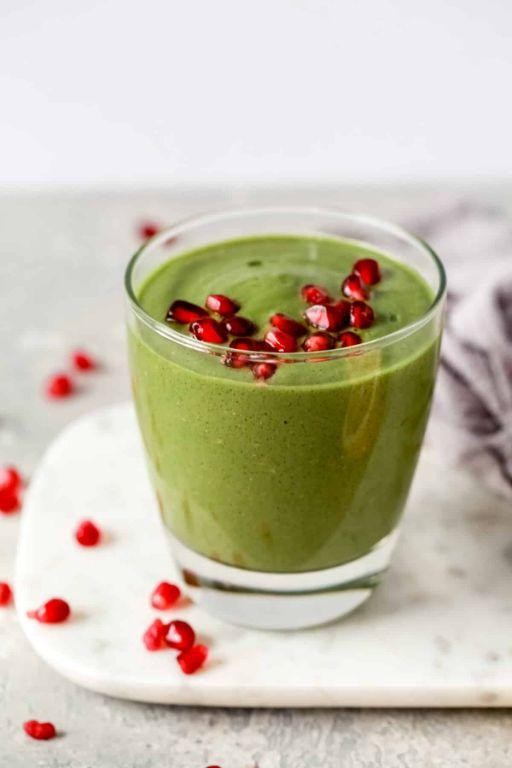
Dawn finds me in the quiet kitchen, measuring ingredients with sleepy hands, remembering how this vibrant smoothie became my gentle morning ritual after a season of rushed breakfasts. Something about the ruby-red seeds swirling through deep green spinach feels like a small, nourishing rebellion against hurried mornings.
1
servings5
minutesIngredients
– 2 cups fresh spinach leaves (I like to gently pack them—not too tight, not too loose)
– 1 cup pomegranate seeds (the jewel-like ones that stain your fingertips crimson)
– 1 frozen banana, sliced (mine always wait patiently in the freezer for this moment)
– ½ cup plain Greek yogurt (the thick, creamy kind that holds its shape)
– 1 tablespoon honey (a generous, golden drizzle)
– 1 cup cold water (straight from the fridge—it keeps everything refreshingly chilled)
Instructions
1. Place 2 cups fresh spinach leaves into your blender first—this helps them blend more evenly.
2. Add 1 cup pomegranate seeds, letting them tumble over the spinach like little gems.
3. Drop in 1 sliced frozen banana—no need to thaw, as the frozen pieces create a naturally creamy texture.
4. Spoon ½ cup Greek yogurt over the fruit, watching it settle into the crevices.
5. Drizzle 1 tablespoon honey in a slow, golden spiral across the other ingredients.
6. Pour 1 cup cold water into the blender, just enough to cover the bottom layer of ingredients.
7. Secure the blender lid tightly—I always press down while twisting to prevent any escapes.
8. Blend on low speed for 15 seconds to break down the larger pieces gently.
9. Increase to high speed and blend for exactly 45 seconds, until the mixture becomes completely smooth with no leaf flecks visible.
10. Stop the blender and check consistency—if it’s too thick, add another tablespoon of water and blend for 10 more seconds.
11. Pour immediately into your favorite glass, noticing how the color deepens as it settles.
The texture is silkier than expected, with the pomegranate seeds’ subtle crunch giving way to the banana’s creaminess. Sometimes I serve it in a mason jar with a striped straw, watching the morning light catch those ruby swirls—a small moment of beauty before the day begins.
Grilled Eggplant with Pomegranate Drizzle

Vividly remembering the first time I tasted this combination, the memory floats back like autumn light through kitchen windows. There’s something about the smoky char of eggplant meeting the jewel-like brightness of pomegranate that feels like a quiet revelation. This dish has become my go-to when I need something that feels both grounding and celebratory.
5
servings15
minutes10
minutesIngredients
– 2 medium eggplants, sliced into ½-inch rounds (I look for ones that feel heavy for their size)
– 3 tablespoons extra virgin olive oil (my favorite grassy one from California)
– 1 teaspoon sea salt (I prefer the flaky kind for better texture)
– ½ cup pomegranate molasses (the thick, syrupy kind that coats the back of a spoon)
– 1 tablespoon honey (local wildflower honey adds lovely floral notes)
– ¼ cup fresh pomegranate seeds (the ruby jewels that make everything sparkle)
– 2 tablespoons chopped fresh mint (from my little windowsill herb garden)
Instructions
1. Preheat your grill to medium-high heat, about 400°F, ensuring the grates are clean and lightly oiled.
2. Arrange eggplant slices in a single layer on a baking sheet and brush both sides evenly with olive oil using a pastry brush.
3. Sprinkle salt evenly over both sides of the eggplant slices, focusing on the cut surfaces where it will penetrate best.
4. Place eggplant slices directly on the hot grill grates, listening for that satisfying sizzle as they make contact.
5. Grill for 4-5 minutes until you see prominent grill marks and the edges begin to soften and curl slightly.
6. Flip each slice using tongs, being careful not to tear the tender flesh now releasing its moisture.
7. Continue grilling for another 4-5 minutes until the second side shows matching grill marks and the flesh feels tender when pressed.
8. Transfer grilled eggplant to a serving platter, arranging them slightly overlapping like fallen leaves.
9. In a small bowl, whisk together pomegranate molasses and honey until fully combined and glossy.
10. Drizzle the pomegranate-honey mixture generously over the warm eggplant slices, watching it pool in the grill marks.
11. Sprinkle fresh pomegranate seeds evenly across the dish, letting them catch in the glossy drizzle.
12. Finish with a scattering of chopped mint, the green flecks providing both color and freshness.
Perfectly tender eggplant melts against the bright acidity of the pomegranate drizzle, creating a dance of smoky and sweet that feels both rustic and elegant. I love serving this warm alongside grilled chicken or letting it come to room temperature for a picnic spread—the flavors only deepen as they sit. The crunch of pomegranate seeds against the silky eggplant creates such satisfying texture contrasts that make each bite interesting.
Roasted Brussels Sprouts with Pomegranate Seeds
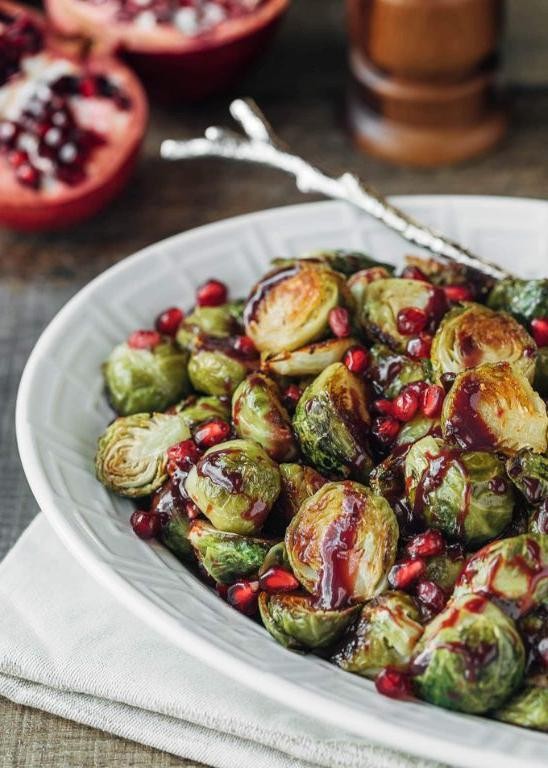
Just now, as the evening light softens outside my window, I find myself thinking about how roasted Brussels sprouts transform in the oven—their edges crisping while their centers turn tender, a quiet kitchen miracle. This version with pomegranate seeds feels like autumn captured on a baking sheet, a simple dish that holds so much comfort.
5
servings10
minutes22
minutesIngredients
– 1 pound Brussels sprouts, trimmed and halved (I look for small, firm ones—they roast more evenly)
– 2 tablespoons extra virgin olive oil (my go-to for its fruity notes)
– ½ teaspoon sea salt (I use fine grain so it disperses well)
– ¼ teaspoon black pepper, freshly ground (it makes all the difference)
– ¼ cup pomegranate seeds (their jewel-like brightness lifts the whole dish)
Instructions
1. Preheat your oven to 400°F, placing a rack in the center for even heat distribution.
2. Toss the halved Brussels sprouts with olive oil, sea salt, and black pepper in a large bowl until each piece is lightly coated.
3. Spread the sprouts in a single layer on a parchment-lined baking sheet, cut sides down to encourage browning.
4. Roast for 20 minutes at 400°F, then check for caramelization—the edges should be golden brown and crispy.
5. Remove the baking sheet from the oven and let the sprouts cool for 2 minutes to settle their texture.
6. Sprinkle the pomegranate seeds over the warm sprouts, gently tossing to combine.
7. Transfer the mixture to a serving dish immediately.
Kindly, the crisp outer leaves give way to a tender heart, while the pomegranate seeds burst with juicy sweetness against the savory roast. I love serving this alongside a simple roast chicken or scattering it over a bed of quinoa for a vibrant lunch—it’s a dish that feels both humble and celebratory.
Pomegranate and Almond Couscous Salad
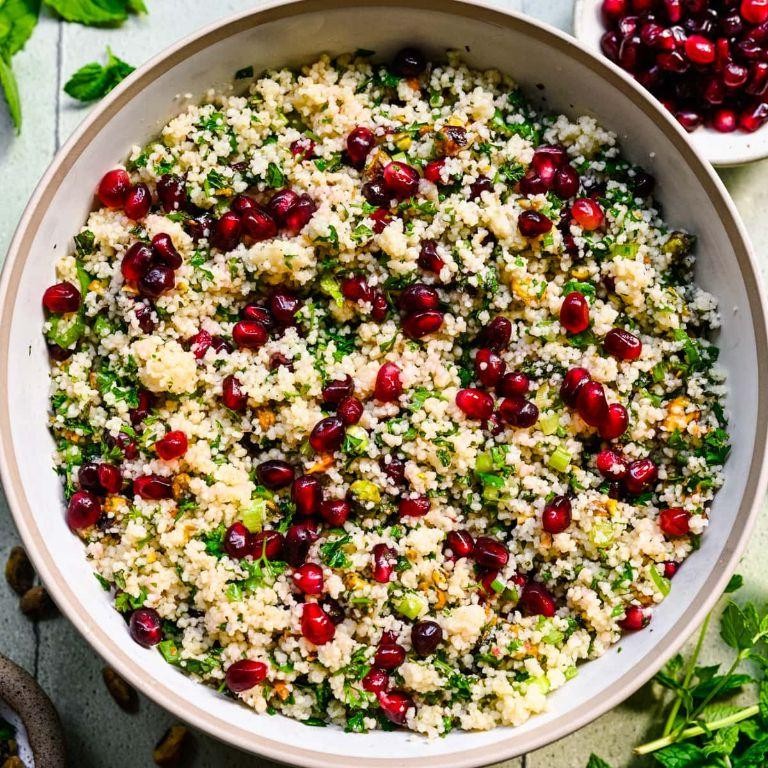
Remembering how the late afternoon light used to catch in my grandmother’s kitchen, I find myself drawn to dishes that hold both color and comfort, like this pomegranate and almond couscous salad that feels like autumn captured in a bowl. There’s something quietly beautiful about how the ruby seeds nestle against the golden grains, a simple meal that somehow makes the shortening days feel less hurried. It’s the kind of food that asks you to slow down, to notice the textures and tastes unfolding with each forkful.
4
servings15
minutes18
minutesIngredients
– 1 cup pearled couscous (I love the way these tiny pearls hold their shape)
– 1 ¼ cups water (just enough to cook the couscous without making it mushy)
– ½ cup pomegranate seeds (their jewel-like brightness always lifts my mood)
– ⅓ cup sliced almonds (toasted until they release that warm, nutty fragrance)
– 2 tablespoons extra virgin olive oil (my go-to for its fruity notes)
– 1 tablespoon fresh lemon juice (squeezed right before using for maximum brightness)
– ¼ teaspoon sea salt (I prefer the delicate crunch it adds)
– 1 tablespoon fresh mint leaves (torn gently by hand to release their aroma)
Instructions
1. Place a medium saucepan over medium heat and add the pearled couscous.
2. Toast the couscous for 3 minutes, stirring constantly until it turns light golden and smells nutty.
3. Pour in 1 ¼ cups water and bring to a rolling boil.
4. Reduce heat to low, cover the saucepan tightly, and simmer for 10 minutes exactly.
5. Remove from heat and let the couscous stand covered for 5 minutes to absorb remaining moisture.
6. Fluff the couscous with a fork, breaking up any clumps gently.
7. Spread the cooked couscous in a thin layer on a baking sheet to cool to room temperature.
8. While couscous cools, place a small skillet over medium-low heat.
9. Add sliced almonds and toast for 4-5 minutes, shaking the pan frequently until golden brown.
10. Transfer almonds to a plate to prevent further cooking.
11. In a large mixing bowl, whisk together extra virgin olive oil, fresh lemon juice, and sea salt.
12. Add cooled couscous to the dressing and toss until evenly coated.
13. Gently fold in pomegranate seeds, toasted almonds, and torn mint leaves.
14. Let the salad rest for 15 minutes at room temperature to allow flavors to meld.
Each bite offers a delightful contrast—the chewy couscous pearls against the crisp almonds and bursting pomegranate seeds creates a symphony of textures that feels both nourishing and celebratory. I sometimes serve it alongside roasted chicken or spoon it into lettuce cups for a lighter meal, though it’s equally satisfying eaten straight from the bowl while standing at the kitchen counter.
Chocolate Pomegranate Bark

Sometimes, the simplest combinations create the most memorable moments in the kitchen, like when dark chocolate’s richness meets pomegranate’s bright, jewel-like burst—a quiet contrast that feels both indulgent and refreshingly light, perfect for savoring slowly.
12
servings15
minutes5
minutesIngredients
– 12 ounces high-quality dark chocolate (I prefer chopping bars instead of chips—they melt more evenly and have a deeper flavor)
– 1 cup pomegranate arils (freshly seeded, as their juicy pop is far superior to dried ones)
– 1/2 teaspoon flaky sea salt (I use Maldon here; its delicate crunch elevates every bite without overwhelming)
– 1 teaspoon coconut oil (just a splash to help the chocolate stay silky and easy to spread)
Instructions
1. Line a baking sheet with parchment paper, smoothing it completely to avoid wrinkles that can mar the bark’s surface.
2. Chop the 12 ounces of dark chocolate into small, uniform pieces—this encourages even melting and prevents scorching.
3. Combine the chopped chocolate and 1 teaspoon of coconut oil in a heatproof bowl.
4. Create a double boiler by setting the bowl over a saucepan of simmering water, ensuring the bottom of the bowl does not touch the water to avoid seizing the chocolate.
5. Stir the chocolate gently and continuously with a spatula until it is fully melted and glossy, which typically takes 4–5 minutes over medium-low heat.
6. Immediately pour the melted chocolate onto the prepared parchment paper.
7. Use an offset spatula to spread the chocolate into an even layer about 1/4-inch thick, working quickly before it begins to set.
8. Sprinkle the 1 cup of pomegranate arils evenly over the chocolate, pressing them in lightly so they adhere.
9. Scatter the 1/2 teaspoon of flaky sea salt across the top, focusing on clusters for balanced seasoning.
10. Transfer the baking sheet to the refrigerator and chill for 45–60 minutes, or until the bark is firm to the touch and snaps cleanly.
11. Break the chilled bark into rustic, irregular pieces by hand for a homemade feel.
Glistening with salt and ruby seeds, this bark offers a satisfying snap that gives way to creamy chocolate and tart juiciness. Try layering shards over vanilla ice cream or gifting them in glass jars tied with twine—each piece feels like a little treasure.
Pomegranate Marinated Lamb Chops

Kind of like the slow, deep red of an autumn sunset, these lamb chops came to me during a quiet evening when I wanted something both comforting and celebratory. The pomegranate marinade stains the meat with such a beautiful color, and the scent that fills the kitchen is sweet, earthy, and entirely nostalgic. It’s a dish that feels like a warm embrace at the end of a long day.
8
chops10
minutes15
minutesIngredients
- 8 lamb loin chops, about 1-inch thick (I find letting them sit out for 20 minutes before cooking helps them sear better)
- 1 cup pomegranate juice (100% juice, not from concentrate, for the best flavor)
- 3 tbsp extra virgin olive oil (my go-to for its fruity notes)
- 2 tbsp honey
- 3 cloves garlic, minced (freshly minced, please—it makes all the difference)
- 1 tsp dried rosemary (crushed between your fingers to release its oils)
- 1/2 tsp salt (I use fine sea salt for even distribution)
- 1/4 tsp black pepper, freshly ground
Instructions
- In a medium bowl, whisk together 1 cup pomegranate juice, 3 tbsp extra virgin olive oil, 2 tbsp honey, 3 cloves minced garlic, 1 tsp dried rosemary, 1/2 tsp salt, and 1/4 tsp black pepper until fully combined.
- Place 8 lamb loin chops in a large resealable plastic bag or shallow dish, and pour the marinade over them, ensuring all chops are coated.
- Seal the bag or cover the dish, and refrigerate for at least 4 hours or up to 8 hours for deeper flavor penetration. (Tip: Don’t marinate longer than 8 hours, as the acidity can start to break down the meat too much.)
- Remove the lamb chops from the refrigerator 30 minutes before cooking to bring them to room temperature for even cooking.
- Preheat your oven to 400°F and place a cast-iron skillet or oven-safe pan over medium-high heat on the stovetop.
- Remove the lamb chops from the marinade, letting excess drip off, and discard the used marinade.
- Sear the lamb chops in the hot, dry skillet for 2 minutes per side until a golden-brown crust forms. (Tip: Avoid moving them around while searing to get that perfect crust.)
- Transfer the skillet to the preheated oven and roast for 6–8 minutes, or until the internal temperature reaches 145°F for medium-rare. (Tip: Use an instant-read thermometer for accuracy—it’s my kitchen essential.)
- Remove the skillet from the oven and transfer the lamb chops to a clean plate.
- Let the lamb chops rest for 5 minutes before serving to allow the juices to redistribute.
Lamb emerges tender and juicy, with a caramelized crust that gives way to the subtle sweetness of pomegranate. I love serving these chops over a bed of creamy polenta or alongside roasted root vegetables to soak up the glossy, reduced pan juices. The contrast between the savory meat and the fruity marinade makes each bite feel like a little celebration on its own.
Conclusion
Joyful pomegranate seeds can transform any dish with their sweet-tart crunch! We hope these 19 recipes inspire your kitchen adventures. Try your favorites and let us know which ones you love in the comments below. Don’t forget to share these delicious ideas on Pinterest so other home cooks can discover these flavorful twists too!



